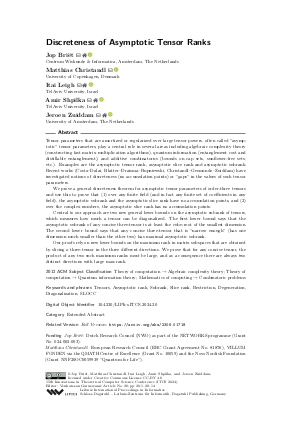@InProceedings{briet_et_al:LIPIcs.ITCS.2024.20,
author = {Bri\"{e}t, Jop and Christandl, Matthias and Leigh, Itai and Shpilka, Amir and Zuiddam, Jeroen},
title = {{Discreteness of Asymptotic Tensor Ranks}},
booktitle = {15th Innovations in Theoretical Computer Science Conference (ITCS 2024)},
pages = {20:1--20:14},
series = {Leibniz International Proceedings in Informatics (LIPIcs)},
ISBN = {978-3-95977-309-6},
ISSN = {1868-8969},
year = {2024},
volume = {287},
editor = {Guruswami, Venkatesan},
publisher = {Schloss Dagstuhl -- Leibniz-Zentrum f{\"u}r Informatik},
address = {Dagstuhl, Germany},
URL = {https://drops.dagstuhl.de/entities/document/10.4230/LIPIcs.ITCS.2024.20},
URN = {urn:nbn:de:0030-drops-195483},
doi = {10.4230/LIPIcs.ITCS.2024.20},
annote = {Keywords: Tensors, Asymptotic rank, Subrank, Slice rank, Restriction, Degeneration, Diagonalization, SLOCC}
}

 Creative Commons Attribution 4.0 International license
Creative Commons Attribution 4.0 International license

